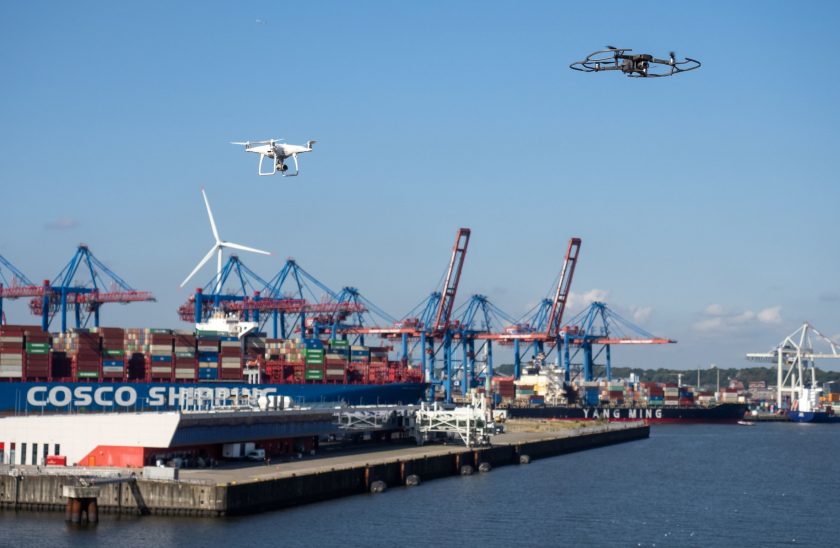Germany is planning to go ahead with the launch of several U-space areas in the country during 2023 following the publication of recommendations and results of the Port of Hamburg sandbox U-space trials.
In a statement published by U-space service provider (USSP) Droniq GmbH, Volker Wissing, German Federal Minister for Digital and Transport said: “With around 400 active companies, Germany is one of the leading markets for drone technologies. We want to strengthen and enhance Germany’s technological lead. The U-space sandbox has answered many important questions for us for the establishment of U-space. We are now using this valuable practical experience to progress onwards. The first U-space areas are to be set up in Germany as early as next year. In doing so, we are ensuring safety in German airspace and facilitating more innovations in unmanned aviation.”
Droniq GmbH and its parent company DFS Deutsche Flugsicherung GmbH, the German air navigation service provider, have published their recommendations for the establishment of U-space areas following the Hamburg trials.
“How U-space areas can function in practice was tested under realistic conditions in a so-called U-space real laboratory, or sandbox, which Droniq and DFS set up in the Port of Hamburg in the north of Germany,” said the press statement. “The seven-month research project had a budget of approximately EUR 1 million and was funded in part by the German Federal Ministry for Digital and Transport (BMDV) (EUR 500,000).
“The Ministry is using the findings and recommendations from the practical tests in the Hamburg U[1]space sandbox to develop a concept for the establishment of U-space areas throughout Germany. The requirements of the European U-space Regulation (2021/664) are also being taken into account. The concept aims to lay all the legal and practical foundations for the implementation of U-space areas.
“The Ministry plans to designate the first U-space areas as early as 2023. Research in this area is also being conducted in another project funded by the Ministry. Known as the LUV project, it is looking into solutions and recommendations for action for the implementation of the U-space Regulation throughout Germany. The aim is to advance the technology of unmanned aviation and to strengthen Germany’s position as an innovative business location in international competition.”
Recommendations from the Port of Hamburg sandbox
The results of the U-space sandbox include recommendations and measures for the establishment of U-space areas, their operation and the design of the roles and services applicable in U-space.
- Among the proposals is the recommendation to establish U-space areas in pilot regions to gain further experience about their implementation and operation. Droniq and DFS recommend using complex airspaces with high levels of unmanned and manned air traffic, such as large cities with airport connections. With more experience, further U-space areas can be introduced, or existing U-space areas can be expanded or connected. A catalogue of criteria developed by Droniq and DFS will help assess when and where it makes sense to establish a U[1]space area.
- Another recommendation concerns the competitive situation in a U-space area. In such areas, USSPs coordinate drone traffic. Generally, there can be several USSPs in a U-space that compete with each other and differ in service and price. “For U-space areas to drive the economic potential that drone operations can offer, there needs to be competition that benefits drone operators,” said Jan-Eric Putze, CEO of Droniq, a leading company in Germany for integrating drones into the airspace. “We look forward to welcoming other market players to U-space alongside ourselves as USSP.”
- Another recommendation is the establishment of U-space areas in the controlled airspace arounds airports, if necessary. “In doing so, we will pave the way for new urban air mobility ideas, for example when it comes to flying from the airport to the city by air taxi,” said Jan-Eric Putze.
- To ensure the efficient networking of all participating agencies in a U-space area, it is recommended to establish a so-called Single Common Information Service Provider (SCISP) for each U-space area. With this as a basis, USSPs can provide their services as demonstrated in the sandbox. Having an integrated air situation for all stakeholders is the core for the safe operation of manned and unmanned air traffic. “The findings from the sandbox show that the implementation of the U-space concept in Germany works,” said Angela Kies, Head of Unmanned Aircraft Systems at DFS. “The implementation can now be rigorously pursued to efficiently facilitate the safe use of drones.”
For more information
https://droniq.de/




